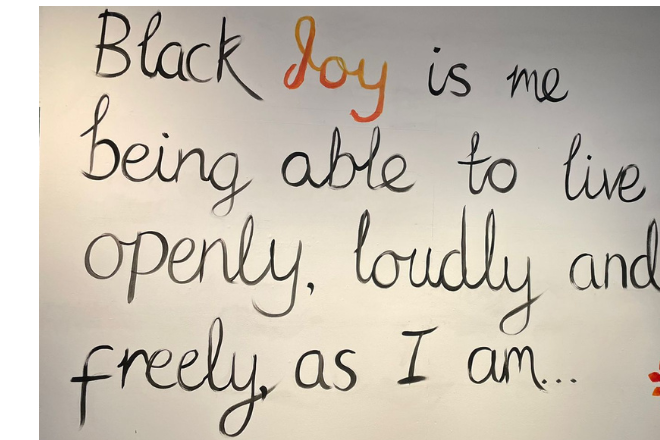The Allies Group helps the Co-Production Collective by giving advice. They use their different experiences, expertise, and skills to help us grow. They support us in making connections, finding ways to tell people about our work, and making sure we can keep going in the future.
The recruitment process
In April 2023, we set ourselves a goal to make the recruitment of our new Allies Group members as inclusive and accessible as possible. You can read about the development of the recruitment process in our blogs from April and June 2023. We set up a Working Group of our co-producers and some of the staff team to design the application process. The group agreed on the following steps to ensure the recruitment process was in line with our aspirations:
- Offering a choice of application methods
- Providing transparency about the functions and details of the role, and the support available
- Setting up a diverse selection panel
- Making the selection process informal, hybrid, co-produced and flexible
- Increasing the diversity of the Allies Group by appointing both academics and co-producers for the role
- Inviting the Working Group as well as our wider community to design the process at every step of the way
In this blog, we reflect on our efforts of designing a fair, inclusive, accessible, and co-produced selection process. As with everything we do, we tried to embrace our Core Values, which are inclusive, kind, transparent, embracing of change, and reflective, in doing this work. We aimed to stay critical of ourselves and challenge ourselves to learn from the positive aspects of the journey and to identify areas where we could further improve in the future. The learnings shared in this blog by the Allies Group recruitment Working Group are based on the feedback of the Allies Group candidates, and members of the Working group and selection panel.
Learnings from the process
What worked well
Practical Conversations
As part of the process, we asked applicants to reflect on a scenario that we shared with them. Candidates appreciated the incorporation of real-life scenarios into the interview, fostering practical and engaging conversations. This approach assessed participants’ skills effectively and also added a dynamic element to the interview.
Hybrid interview model
We offered candidates various options to join the interview, such as online video call or in-person interview, to make the format accessible and inclusive to all. We also provided a video submission option for those unable to attend.
The hybrid interaction with other applicants was generally well-received. It allowed people to connect and encouraged a sense of community. Some participants found it challenging to connect with candidates who joined the conversation online. Nevertheless, the hybrid format was considered a success, with fair application questions contributing to a positive experience.
Inclusive application options
To apply, candidates were encouraged to choose a format most suitable to them. For those that didn't want to submit a written application form they could provide a voice recording, video recording, or take part in a video call that was later transcribed by our team.
Based on our feedback, the intentional inclusivity of offering various methods was appreciated. Knowing there were different options for submitting applications made candidates feel welcomed and catered to people’s individual preferences and circumstances. However, it was pointed out that attending the session live provided additional opportunities, potentially creating an uneven playing field for those who submitted video clips of their responses. While the scores may not reflect this imbalance, this feedback allows for some consideration on how to make opportunities equal for all candidates across all interview formats.
Awareness and Validation
To conduct the interview, we chose a group interview format, wherein participants could interact with each other, to foster a sense of community as well as to create a more comfortable and less formal interviewing format.
The group interview led to increased awareness of co-production and validation for people, both applicants and panel members. As a result of the group conversations and engaging with each other, they recalled gaining a deeper understanding of challenges of co-production. Some of the examples they mentioned were co-producing an inclusive and accessible selection process, as well as the importance of incorporating trauma-informed practice into our processes.
Areas for improvement
Some candidates felt that a longer interview timeslot than 1 hour 15 minutes would have been beneficial. They mentioned the need to foster an atmosphere that allows for thoughtful responses without feeling rushed. On the positive side, transparency about the interview questions before the interview was seen as a great step towards an accessible selection process.
Proposing more probing questions
During the conversation, candidates were asked a variety of questions that we shared with them prior to the interview to assess their skills and experience. In addition, candidates were provided in advance with the criteria against which we were assessing applications.
In their feedback, participants wished for more questions or probes about the discussed topics during the interview. This would allow for a more comprehensive understanding of candidates' perspectives, and also contribute to a more conversation-like interview process, as opposed to relying only on the questions we shared with them beforehand.
Less panel members
To promote diversity within the selection process, nine panel members with a variety of lived and learnt experience assessed the interviews. This number was settled on to make sure that there were enough people to capture notes on what was being shared by each candidate and to ensure that multiple panel members were assessing each candidate so addressing any potential bias but in hindsight we felt as a group that perhaps we could have done this with fewer panel members.
The participants’ feedback suggested the need for less panel members at the interview. Some candidates felt that the high number of panel members created an unbalanced dynamic and contributed towards them feeling nervous during the interview. Less people evaluating their performance to maintain balance and fairness was suggested.
Redesigned feedback collection
At the end of the interview process we asked candidates to complete a short feedback form so that we could gather thoughts on how to improve the process.
The feedback mechanism at the end of the interview was criticized for feeling somewhat forced and unnatural as part of the wider experience of the process. Candidates suggested refining this process to make it more meaningful.
Clarity in Shortlisting
It was pointed out that clearer options for participants to categorise their background/reason for applying during the initial application and shortlisting process would have been useful to ensure a good balance between academic and community member candidates. To address this, adding specific checkboxes for community, organisation, or both, would enhance clarity and avoiding confusion in the application process.
Transparency in Interview Logistics
Panel members felt that a scoring system with clear descriptions for each score and or a list of “ideal” answers would have been a beneficial tool to assist them in the objective assessment of candidates. A key takeaway was the need for more dedicated time for the panel to align on evaluation criteria, emphasising the human aspect of decision-making. We acknowledge the importance this information for panel members and will work on providing comprehensive information regarding the interview format and structure in the future.
Reflections and impact
The feedback from this process is very important to us, the process has revealed just how difficult it is to be both fair and inclusive during recruitment processes. This process has been a learning journey, with both successes and opportunities for improvement. The feedback received will be key in refining our approach to equal and accessible recruitment, ensuring a more engaging and effective process in the future.
We were really pleased to see, that participants mentioned gaining fresh perspectives and insights, emphasising the value of creating an environment where everyone feels valued. This together with our passion as a community for equity and inclusivity is reason enough for us to continue learning in this space and furthering our practice as part of future recruitment processes.
Photo Credit: Elements5Digital from Unsplash





.png)

.png)
.png)


.png)
.png)
.png)